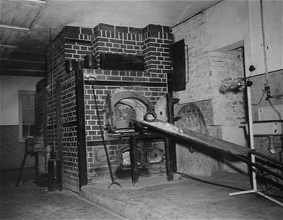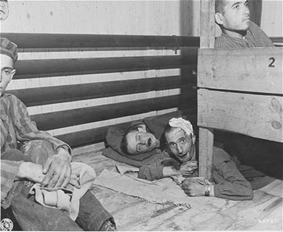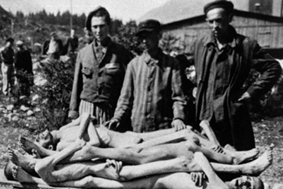
Crematories in Ebensee
(sub-camp of Mauthausen)
by Mark Vadasz
- Location: At the southern tip of the Traun lake aprox. 75 kilometers SW of Linz (Austria).
- Established: 18 November 1943
- Liberated: 9 May 1945
- Estimated number of victims: Aprox. 20.000

Crematories in Ebensee
Together with the Mauthausen sub-camp of Gusen, Ebensee is considered to be one of the most diabolic concentration camps ever built.
The construction of the sub-camp began in late 1943 and the first 1.000 prisoners arrived on 18 November 1943 from the main camp of Mauthausen and other Mauthausen sub-camps. The main purpose of Ebensee was to provide slave labour for the construction of the enormous underground tunnels in which armament works were to be housed.
After rising at 4:30 A.M. the prisoners dug away at the tunnels until 6 P.M. After some months work was done in shifts 24 hours a day. There was nearly no accomodation to protect the first batch of prisoners from the cold Austrian winter. Thus the death toll increased astronomically. Bodies were piled in heaps and every 3-4 days they were taken to the Mauthausen crematorium to be burned. Ebensee did not yet have its own crematorium. The dead were also piled inside the few huts that existed. The smell of the dead, combined with sickness, phlegmon, urine and faeces, was unbearable. The prisoners wore wooden clogs. When the clogs fell apart the prisoners had to go barefoot. Due to this total illtreatment combined with food allocations consisting of , in the morning: half a liter of ersatz coffee, at noon three-quarters of a liter of hot water containing potato peelings, in the evening 150 grams of bread, the death toll continued to rise. Soon lice infested the camp.
The camp was surrounded by a barbed wire fence, small towers with machine guns and shacks for the SS.
The Mauthausen commendant Franz Ziereis sent his most capable and vicious man to head the camp, Georg Bachmayer. After establishing his rule, he once again returned to Mauthausen and left the camp under the command of an Obersturmfûhrer who proved to be totally deranged. The combination of these two became a reign of terror.

Survivors in Ebensee.
One of their favourite methods of torture was to tie a prisoner´s arms behind him, with the hands side by side and thumb to thumb and then suspend him from a tree about eighteen inches off the ground. Bachmayer would then let his favourite dog, an Alsation called "Lord", loose. The prisoner would be left in this unspeakable torture to die a slow and agonizing death.
In early 1944 a new commandant was appointed in Ebensee, Obersturmfûhrer Otto Riemer. During his period the conditions deteriorated even further. He personally beat, shot and tortured prisoners daily. He openly offered extra cigarettes and leave to those sentries who could account for the largest number of deaths. If a sentry at the end of a day had not a sufficient number to his credit, he would knock off the cap of a prisoner and throw it into a forbidden area. When the prisoner went to retrieve it, he would be shot dead.
Riemer like Bachmayer was a great lover of wine and women, and he would often go to wild drinking parties with some of the younger SS. On one occasion, May 18 1944, he returned to camp after an all-night drinking session with 12 of his SS command. They entered the camp shooting wildly with their pistols and roaring with delight as panic stricken prisoners scurried out of their way. 15 prisoners died as a result of this display.
Eventually the camp expanded and prisoner blocks were established. The leader of block 19 was an extreme sadist. He would wait for his prisoners to return from the day´s toil and then compel them to perform exhausting physical exercises far into the night. The following morning after a sleepless night, the men would be forced out to another full days work. Nearly all the members of his block died from exhaustion within ten days. By this sytem of elimination he had succeeded in killing in a most economical manner and was rewarded. When the sub-camp at Wels was constructed, he became the camp leader.
Ebensee also had its own crematorium. It was built apart from the other buildings with an enormous single chimney which rose high into the air.
Block 23 corresponded to the "Bahnhof" at Gusen or the "Russenlager" at Mauthausen. Here the dead and the living dead were flung together in big heaps. When the camp was at full strength, as many as 600 prisoners lay on the bare floor at one time.
When the war was coming to an end, the mass evacuation from other camps put tremendous pressure on the Mauthausen complex which was the last remaining camp in the area of Nazi power. The 25 Ebensee barracks were designed to hold 100 prisoners each. At the most they held 750 each. To this number one has to add the prisoners being kept in the tunnel systems and outside under the open sky. The creamatorium was of course unable to keep pace with the deaths. Naked bodies lay stacked up outside the blocks and the crematorium itself. At the closing weeks of the war, the death rate exceeded 350 a day.
To reduce congestion, a ditch was dug outside the camp and the bodies were flung into the quicklime. On one day in april 1945, a record number of eighty bodies were removed from block 23 alone. Amongst the pile, feet were seen to be twitching. During this period, the inmate strength reached a new high of 18.000 prisoners.

Liberation of Ebensee on May 9th, 1945.
US troops liberated Ebensee on May 9, 1945. Around May 19, 1945 Bachmayer commited suicide after first shooting his family. Riemer managed to escape.